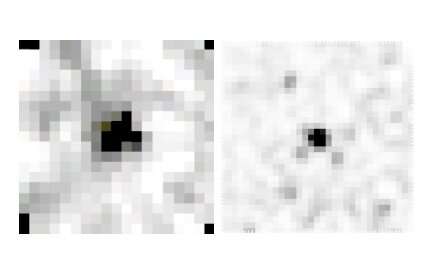January 29, 2019 report
Ultra-luminous infrared galaxy with strong ionized-gas outflow discovered

Japanese astronomers report the identification of a new ultra-luminous infrared galaxy (ULIRG) as part of the search for far-infrared-bright but optically faint objects. The newly detected ULIRG, designated AKARI-FIS-V2 J0916248+073034, exhibits a strong ionized gas outflow. A paper detailing the discovery was published January 17 on arXiv.org.
With infrared luminosities of over 1 trillion solar luminosities and star formation rates between 100 and 1,000 solar masses per year, ULIRGs are the most intensely star-forming galaxies in the local universe. Hence, finding new galaxies of this type could be important for improving the understanding of star formation and evolution.
A team led by Xiaoyang Chen of Tohoku University in Japan is interested in detecting new objects of the ULIRG population. They are constructing a sample of ULIRGs at intermediate redshifts (between 0.5 an 1.0). For this purpose, they have performed an optical follow-up program for far-infrared sources available in the AKARI Far-Infrared Surveyor (FIS) Bright Source catalog by using optical imaging data from the Sloan Digital Sky Survey (SDSS).
Their study resulted in the discovery of a new ULIRG at a redshift of approximately 0.5, which received designation AKARI-FIS-V2 J0916248+073034, or J0916a for short. "In this paper we report a discovery of one ULIRG selected from AKARI 90-μm FIR survey, AKARI-FIS-V2 J0916248+073034 (hereafter J0916a)," the researchers wrote in the paper.
According to the study, J0916a has a total infrared luminosity of about 6.13 trillion solar luminosities and an estimated star formation rate of nearly 1,000 solar masses per year. The galaxy's stellar mass was calculated to be around 94.6 billion solar masses.
The researchers found that J0916a showcases signatures of an extremely strong outflow in its emission line profiles. They noted that high- and low-ionization potential lines show large velocity dispersions and shifts in relative to the stellar absorption lines. "J0916a shows extreme outflow not only in the [O III] emission line, but also in the [O II] emission line," the paper reads.
The study reveals that the outflow in J0916a most likely extends to a radius of about 13,000 light years. The astronomers say that this outflow is among the most powerful observed in ULIRGs and quasars at redshifts between 0.3 and 1.6, as it has the mass outflow and energy ejection rates estimated to be at a level of around 500 solar masses per year and approximately 400 tredecillion erg/second respectively.
Given that J0916a exhibits such strong outflow and an intense star formation process, the authors of the paper assume that the star-forming region of the galaxy has not yet been severely affected by the outflow.
In concluding remarks, the researchers suggest further observations of J0916a in order to reveal the properties and origins of the outflow. For instance, they propose spectroscopy observations with higher spatial and spectral resolution to determine the electron density in the outflowing gas, and integral-field spectroscopy to investigate the structure of the outflow.
More information: Xiaoyang Chen et al. Discovery of a strong ionized-gas outflow in an AKARI-selected Ultra-luminous Infrared Galaxy at z = 0.5. arXiv:1901.05618 [astro-ph.GA]. arxiv.org/abs/1901.05618
© 2019 Science X Network




















